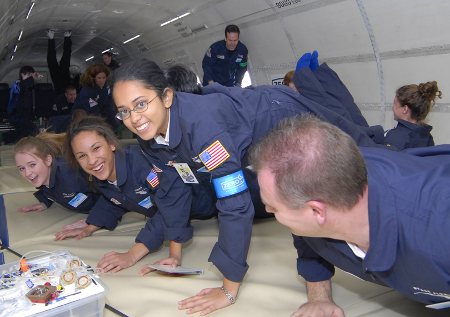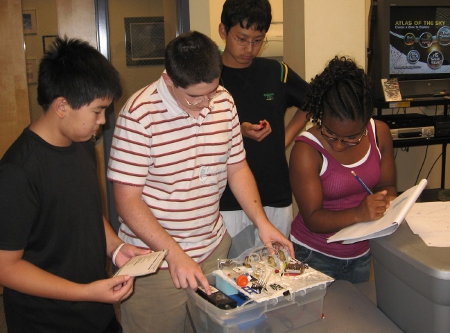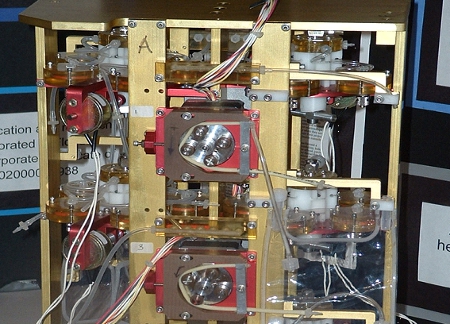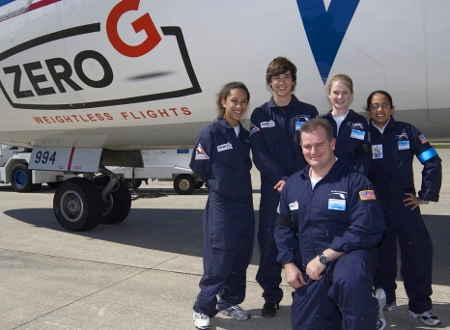Feature: Unlimited Space

Kevin Simmons and students have fun and perform experiments in Zero-G.
Many kids dream of exploring space, but few get much further than their schoolyards. This is not true of students in Tekna-Theos, a Florida after-school program bursting with science activities and contests. They’ve set their sights high, designing and building mini-satellites and preparing a payload to test the effect of weightlessness on bone cells. Some have actually experienced “Zero-G.”
The instructor who inspires such out-of-this-world science is Kevin Simmons, who delights in watching students tackle hands-on challenges. “Young kids don’t know why things can’t be done,” he says.
Nor should they, when, under Simmons’ guidance, they can participate in a sophisticated research project like BLUE Cube. Still in the proposal stage, this three-stage project would have students assembling and testing bread-loaf-sized satellites called CubeSats, which come in a kit. The CubeSats would then be launched via rocket into Low Earth Orbit, where they observe the Earth’s atmosphere and chosen sites such as glaciers. Space agency staff and graduate students would assist with experiments. In the third stage, data from these experiments would be downloaded to classrooms.
Already, Tekna Theos, Inc. (TTI) students are exploring complicated questions involving human survival in space. One is: Why do astronauts lose bone mass? Is microgravity the cause, and is there a way to stop that from happening?
To find the answer, a group of students is at work on the design and construction of a bioreactor, an enclosed lab containing everything needed to support small life forms, like plant matter, phytoplankton, or algae. With special parts supplied by NASA, the bioreactor would become part of the payload on a space flight. The intent is to observe how osteoblasts – bone-forming cells – behave in microgravity.

Students work together on a version of their bioreactor for use in Zero-G.

A close-up of the full bioreactor and its components.
Simmons, a chemist who previously worked in industry and on military-funded cancer research, saw a chance to engage students through hands-on science while a high school teacher at Orange Park (Fla.) Christian Academy.
In 2001, he created a school club with an aerospace theme. Unable to get outside funding because of the school’s religious affiliation, he formed a nonprofit organization offering after-school activities to students throughout northeastern Florida. Although its Greek name “Tekna-Theos” roughly translates to “Children of God,” the group imposes no religious requirement for joining its many activities, projects, and contests.
Student participation is free. TTI is funded through partnerships with corporations, including Northrup Grumman, along with nonprofit organizations and state agencies like Space Florida, run by the state’s lieutenant governor. One perk of such partnerships is the occasional chance for students to ride and conduct experiments aboard Zero-G aircraft for free. In fact, Simmons picked the first four grade school students ever to ride on that type of aircraft.

Simmons and the first four Zero-G students pose in front of the aircraft.
The group has no permanent building; lab work is performed at various schools. Lately, it has mostly been using the Aviation Center of Excellence at Florida State College-Jacksonville. “We are not a brick-n-mortar building place, and [we] go where the action is,” Simmons says. TTI also has a summer camp for students as well as teachers.
The organization is split into three divisions (Cell Biology, Engineering, and Marketing), each managed by an upperclassman. The engineering group learns about hydraulics, pump design, power supplies, heating and cooling elements, sensors, and data collection.
Tekna-Theos has brought recognition both to Simmons and to his students. Simmons is currently a National Science Foundation Einstein fellow. (Another fellow, John Moore, has collaborated with him on BLUE Cube.) Through TTI, students from around the world have teamed up for several design and aerospace-related contests, including the Pete Conrad Spirit of Innovation Award from X-Prize. The kids who won in 2009 did so with an algae-based bioreactor, and one of the students used the prize money to buy a laptop for college.
“I’ve lived long enough to see the original kids do well,” Simmons says. If a program plays to the strengths of individual students and gives them ownership in what they’re doing, he says, then it is far more likely that they will excel.
Filed under: Special Features
Tags: Aeronautics, Aerospace, Aerospace Engineering, Biomolecular Engineering, CubeSat, NASA, Satellite, Satellite imagery, Satellites, Space, Teachers








